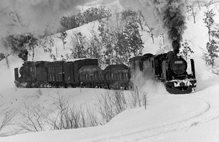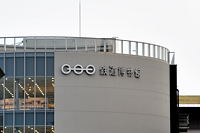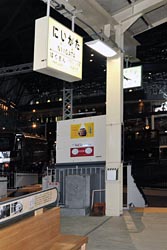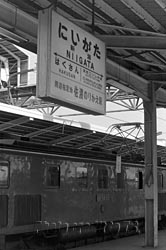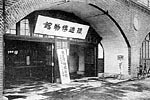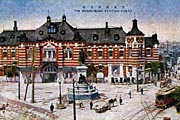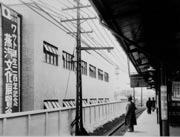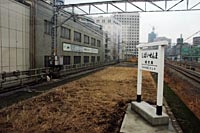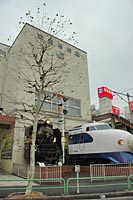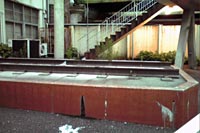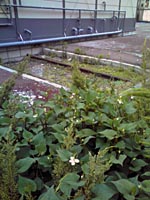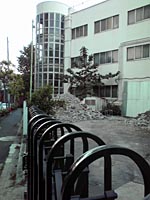The Railway Museum
in Saitama
Preserved Locomotives and Railcars
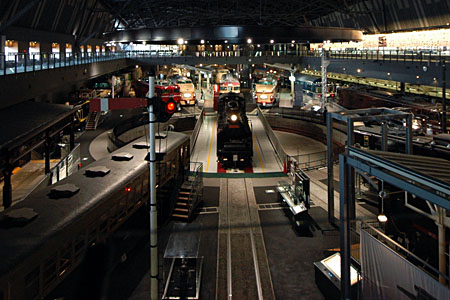
|
This renewed Railway Museum was opened at Omiya in Saitama city on the 14th of October 2007. This museum is the oldest and biggest railroad museum in Japan. The museum was originally at Kanda-Manseibashi in Tokyo's downtown area until the 14th of May 2006. It was there for 70 years. After WW2, the museum not only exhibited railroads but marine and aviation transportation also, and it was called the "Transportation Museum".
These engines and railcar descriptions are mentioned on the Railway Museum official website with accompanying English. However, the descriptions were too short... So I am giving more detailed explanations for visitors who may have already gone, or who are planning to go. I have also included more recent photos in addition to the older photos. (Imperial cars, Shinkansen cars and freight cars are not included.)
Introduction The History of the Railway Museum 40 years have passed since Japanese railroading began during May 1911, government railway created a new division called the "Museum Section". The reasons for the exhibit was the increased historical value of railroad collections. Those collections were kept under the elevated railway in Yurakucho. The new museum's opening day was targeted between June and July of 1911, but this plan was derailed because of financial troubles. Eventually, these were only exhibited at Yurakucho's storage area between May 26th and May 31st during 1911. And after that the Museum Section was dissolved. Afterward, the collections were transferred to the "Railrolad Secretariate Research Center" (present JR Railway Technical Research Institute). during June 1919 with Mr. M.Nanami as the newly-installed chief. He took a proactive stance to the museum after it's opening. Accordingly, he freed up about 330 square meters (275 sq yards) of land under the elevated area between Tokyo and Kanda. A small Temporary-Railway Museum was opened only to applicants. This Temporary-Museum received a great response from the citizens. So, the Ministry of Railways extended the museum area to 2,640 sq meters (2,207 sq yards), and the museum was opened to the public between the 14th and 23rd of October 1912 as the celebration of the railway opened for the 50 year memorial. 580,000 visitors came for the ten day period. But, the museum again went back to only applicants after the anniversary.
During 1921, a new museum plan was decided upon to build in Shinjuku, but the budget was again frozen when a Minister of Railroads was changed the next year. During the 8th of April 1925, under the elevated location between Tokyo and Kanda the museum was reopened. But under the elevated site of the museum space was soon exhausted. So, newly planned locomotives, No.150, No.9856, No.5000 and No.3983 (Japan's first Rack Track System steam engine) were not able to be exhibited at the museum. For that reason, they were kept at other sites.
During 1919, Manseibashi terminal became a mid-way station and was opened between Manseibashi and Tokyo station. The station received big damage from 1923's Great Kanto Earthquake. The station was repaired, but a big terminal was no longer needed. As a result, during1934, Manseibashi station was reduced in size. And new museum construction was decided to be part of Manseibashi's station site. Eventually, a new Railway Museum was opened at Manseibashi in Tokyo's downtown area on the 26th of April 1936. After Manseibashi's Railway Museum was opened, the museum and Manseibashi station buildings were used together, until Manseibashi station closed on the 1st of November 1943. A vestige of Manseibashi remained until its closing, such as the station hall, platform entranceway, stairs and platform. Remains could be seen on special occasions. In the following left photo, left building is a museum, and original Manseibashi platform site. Photo took in special publication day 2006.
However, in the 1940s, Japan went on to a war footing, so, military information was secret. Ultimately, No.5000 and No.3951 had no space in the museum so they were scrapped and the iron was used in the war. On the 10th of March 1945, a massive air raid turned downtown Tokyo into complete ruins. The neighborhood of Manseibashi was burned, but the museum had a miraculous escape from the disaster. But the musem was closed from that day.
In addition, a GI by the name of William Eliot was interested in model railroading. He completed a huge HO scale layout in his spare time. The layout took a whole year to complete. This layout was named the "Eliot Room", and it became a very popular display in the museum. A huge layout was also made in Saitama's new museum.
During January 1952, the museum site was expanded. According to the statistics of 1953, 65% were children among 380,000 visitors. During 1961, the limited express train "Kodama" motif was modeled in to a dining room and was opened. The last steam locomotive C57-135 was exhibited in May 1975. A head-cut off of the first Shinkansen car (No.21-25) and stem engine D51-426 were exhibited in front of the main entrance during April 1978. On the 1st of April 1987, the museum was transfered from JNR to JR-East by division and privatization of Japan National Railways. On the 14th of May 2006, after 70 years, the Manseibashi Museum was closed and reopened on the 14th of October 2007 at Omiya Saitama city. After being moved, the Manseibashi museum site during May 2009
|
